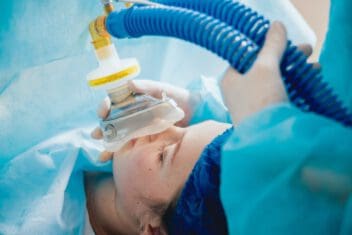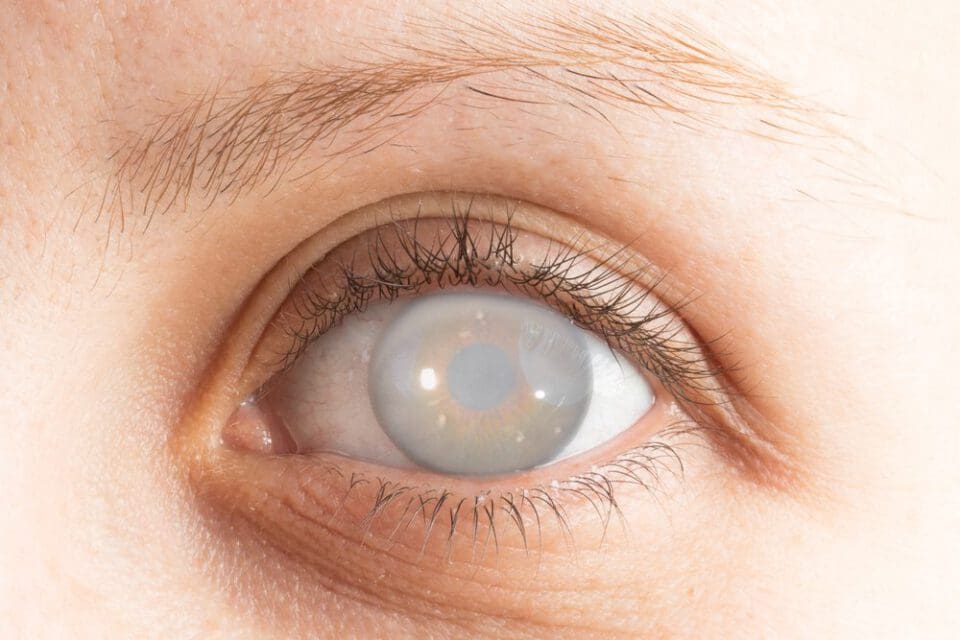
Medically Reviewed by Amarpreet Brar, M.D.
Further Reading
Cataract Surgery Anesthesia: Options, Preparation and What to Expect
Home / Guide to Cataract Surgery /
Last Updated:

Medically Reviewed by Amarpreet Brar, M.D.
A cataract occurs when the lens of the eye becomes cloudy and needs to be repaired through surgery. Usually, a replacement lens is implanted.
Table of Contents
This is a surgical procedure that requires anesthesia. Anesthesia for cataract surgery is the medication used to numb the eye so you do not feel it during the procedure.
Since cataract surgery is an outpatient procedure, lasting only about an hour or less, you will remain awake and receive local anesthesia in the form of eye drops or a needle-based block most of the time. In most cases, you receive a sedative or other medications to help you relax.
To prepare for cataract surgery and anesthesia, you will need to follow your doctor’s instructions. Refrain from eating or drinking 8 hours before surgery. You need to take any necessary medications as directed, and be sure you have someone to drive you home from the procedure.
Anesthesia for Cataract Surgery

Nearly 10 million cataract surgeries are performed around the world every year, making it one of the most common surgical procedures.
Anesthesia is the administration of medications to block or numb pain during a surgical procedure. It is usually provided by a special doctor called an anesthesiologist.
Since cataract surgery is fairly quick and minimally noninvasive, the anesthesia is usually light. The eye can be numbed locally, eliminating the need for full sedation most of the time.
The doctor will numb your eye itself and generally keep you awake during the surgery. You will often be given either oral or intravenous (IV) medications to help you relax and remain comfortable.
Common Forms of Anesthesia for cataract surgery
Eye surgeons have a variety of anesthetic options at their disposal for a cataract procedure. In conjunction with your doctor, you will get to decide which option is right for you.
The most common types of anesthesia used in cataracts and other types of surgery are:
You deserve clear vision. We can help.
With 135+ locations and over 2.5 million procedures performed, our board-certified eye surgeons deliver results you can trust. Your journey to better vision starts here.
- Topical anesthesia
- Needle-based eye block
- Facial nerve block
- General anesthesia
If you’re in good health and can remain comfortable and relaxed during the procedure, then local anesthesia can be a better option for you. On the other hand, if you struggle with a medical condition that makes you restless or if you have anxiety issues, full sedation is recommended.
Topical Anesthesia
Topical anesthesia is the most popular, followed by injectable blocks.
As the doctor operates, you’re likely to stay awake. The doctor will give drop a numbing agent in your eye. The doctor may also use lidocaine, an anesthetic agent, to inject the area around or inside the eye. This is often used to minimize or suppress pain post-surgery. Lidocaine and eye drops are often used together.
Needle-Based Eye Block
Needle-based eye block, otherwise known as the retrobulbar block, is another type of local or regional anesthesia. In this procedure, the pain-numbing medicine is injected into the retrobulbar area, the space behind the eye globe.
This results in akinesia of the extraocular muscles, which block the three cranial nerves that influence the movement of the globe. Needle-based eye block also works by providing sensory anesthesia of the cornea, uvea and conjunctiva by suppressing the ciliary nerves. Injectable medication such as lidocaine is also used in this technique.
General Anesthesia
General anesthesia is physician-delivered sedation, a medical procedure administered through a mask or an IV placed in the vein. While the anesthesia works, you’ll be unconscious, and many of your body’s functions will slow down or need help to work effectively.
Your doctor may place a tube in your throat to help you breathe. During surgery, the physician/anesthesiologist will monitor your heart rate, blood pressure, breathing and other vital signs. And you remain unconscious, free of pain.
Once the operation is completed, the doctor will reverse the medication and wake you up. Nurses will continue monitoring your circulation, breathing patterns and oxygen levels as well as your vitals.
Some people may feel fine after undergoing anesthesia, while others may experience chills, nausea, or vomiting. However, your doctor will help you manage and cope with these side effects of general anesthesia.
Ideally, general anesthesia for cataract surgery is often used in young children, people with particular mental and emotional needs, and people who suffer from acute anxiety. The sedatives help them to relax during the procedure.
Relaxation Medications for Cataract Surgery
These medications are often administered to help you relax and stay calm during the operation. They are often administered orally or through injection or IV. These medications also help you avoid the memory of the procedure and can be administered depending on body weight and overall health. However, for general anesthesia, the anesthesiologist will need to use the lowest doses of medications for anesthesia and relaxation.
Anesthesia After Surgery
Anesthesia for cataract surgery typically wears off after an hour or two, and you can go back home soon afterward. However, the drugs can stay in your system for up to 48 hours.
The benefits of anesthesia include the ability to suppress or avoid pain through numbness and to keep you comfortable and relaxed throughout the procedure (3). However, the less medication your anesthesiologist administers, the better. Your doctor will take you through each option to determine one that works best for you.
Is Anesthesia Necessary for Cataract Surgery?
Doctors sometimes get asked by patients if anesthesia is necessary for cataract surgery. The answer is yes.
The surgery, known as phacoemulsification, involves a tiny cut in your eye. The affected, cloudy lens is expertly removed from the eye, and a new, artificial lens is implanted in its place.
Because of the precision nature of the procedure, it’s imperative that the patient can tolerate needles and lasers operating on the eyes. No anesthesia leaves this up to chance, not something surgeons like to do. The risk of a patient moving or flinching during a delicate procedure can only help minimize the effect of the procedure.
The operation involves using an intraocular lens to correct the cloudiness in the eye. It is not an invasive procedure and can be performed with a laser. The doctor will first administer anesthesia to numb your eyes before conducting the procedure.
Doctors perform an estimated 10 million cataract surgeries a year worldwide, making it the most common medical procedure. It usually takes 15 to 60 minutes, and you can go home as soon after it is done.

Anesthesia Risks & Benefits During Cataract Surgery
All surgical procedures carry some risk, but in general, cataract surgery and the anesthesia used are considered safe. The surgery has a high success rate.
Most of the risks related to cataract surgery involve complications from the surgery itself, such as infection, inflammation, retinal detachment, dislocation of the lens, vision loss, or a secondary cataract.
Complications related to anesthesia for cataract surgery usually involve reactions to medications, but there can be issues related to injections as well. Injections into the eye can cause perforations or damage to the muscle, and general anesthesia can involve risk of central nervous system depression. Topical anesthesia carries fewer of these potential hazards, but you will need to be able to hold completely still throughout the procedure.
Cataract surgery generally improves vision in most people. It can be performed quickly at a surgical center with few complications and low levels of risk.
Pros of cataract surgery anesthesia include the ability to numb potential pain and keep you comfortable during the procedure. Usually, the less medication the better. Your doctor will work with you to decide on the proper dosage and level of anesthesia that will be right for.
You deserve clear vision. We can help.
With 135+ locations and over 2.5 million procedures performed, our board-certified eye surgeons deliver results you can trust. Your journey to better vision starts here.
References
- Cataract Surgery. (October 2011). CMAJ JAMC.
- Are There Different Types of Cataract Surgery? (August 2017). All About Vision.
- Are You Awake During Cataract Surgery? (August 2017). All About Vision.
- Aesthesia for Cataract Surgery. (2019). American Academy of Ophthalmology (AAO).
- Anesthesia for Cataract Surgery: Recent Trends. (December 2010). Oman Journal of Ophthalmology.
- Cataract Surgery. (March 2018). Mayo Clinic.
- Types of Anesthesia. American Society of Anesthesiologists.
- Anesthesia for cataract surgery: Recent trends. (December 2010). Oma Journal of Ophthalmology.
- Anesthesia Management During Cataract Surgery: Summary. (July 2000) NCBI.

Dr. Brar has been a board-certified ophthalmologist for more than 15 years, and has performed over 15,000 eye surgeries. He specializes in all-laser Custom LASIK, PRK, cataracts, intraocular lens implants and Wavefront technology.
This content is for informational purposes only. It may have been reviewed by a licensed physician, but is not intended to serve as a substitute for professional medical advice. Always consult your healthcare provider with any health concerns. For more, read our Privacy Policy and Editorial Policy.